Multiband Frequency Tuneable Antennas for Selection Combining Strategy in White Space Applications
Abstract
1. Introduction
2. Antenna Design
2.1. Antenna Structure
2.2. Digitally Tunable Capacitor
3. Simulation Results
4. Measurement Results
5. Antenna Diversity System
6. Conclusions
Author Contributions
Funding
Conflicts of Interest
References
- Zhou, H.; Zhang, N.; Bi, Y.; Yu, Q.; Shen, X.S.; Shan, D.; Bai, F. TV White Space Enabled Connected Vehicle Networks: Challenges and Solutions. IEEE Netw. 2017, 31, 6–13. [Google Scholar] [CrossRef]
- Song, M.; Zheng, M. Ecology-based coexistence scheme for heterogeneous cognitive radio networks over TV white space. IET Commun. 2018, 12, 620–626. [Google Scholar] [CrossRef]
- Zhang, W.; Yang, J.; Zhang, G.; Yang, L.; Kiat Yeo, C. TV white space and its applications in future wireless networks and communications: A survey. IET Commun. 2018, 12, 2521–2532. [Google Scholar] [CrossRef]
- Rahman, M.; Ismail, D.; Modekurthy, V.P.; Saifullah, A. LPWAN in the TV White Spaces: A Practical Implementation and Deployment Experiences. ACM Trans. Embed. Comput. Syst. 2021, 20, 1–26. [Google Scholar] [CrossRef]
- Petosa, A. An Overview of Tuning Techniques for Frequency-Agile Antennas. IEEE Antennas Propag. Mag. 2012, 54, 271–296. [Google Scholar] [CrossRef]
- Srivastava, S.; Singh, V.; Gupta, S.K. Reconfigurable Antenna for Cognitive Radio System. In Next-Generation Antennas, 1st ed.; Ranjan, P., Jhariya, D.K., Gupta, M., Kumar, K., Kumar, P., Eds.; Wiley: New York, NY, USA, 2021; pp. 143–154. [Google Scholar] [CrossRef]
- Kumar, S.; Rayavarapu, N. A unique frequency reconfigurable monopole antenna for TV white space applications. Frequenz 2022, 76, 361–366. [Google Scholar] [CrossRef]
- Bhole, S.; Rathod, A.; Doddipalli, S.; Kannaiyan, S.; Kothari, A. A Compact Planar Antenna with Meander lines for TV White Space Applications. In Proceedings of the 2018 IEEE International Students’ Conference on Electrical, Electronics and Computer Science (SCEECS), Bhopal, India, 24–25 February 2018; pp. 1–4. [Google Scholar] [CrossRef]
- Bouyedda, A.; Barelaud, B.; Gineste, L. Design and Realization of an UHF Frequency Reconfigurable Antenna for Hybrid Connectivity LPWAN and LEO Satellite Networks. Sensors 2021, 21, 5466. [Google Scholar] [CrossRef] [PubMed]
- Qin, P.Y.; Weily, A.R.; Guo, Y.J.; Bird, T.S.; Liang, C.H. Frequency Reconfigurable Quasi-Yagi Folded Dipole Antenna. IEEE Trans. Antennas Propag. 2010, 58, 2742–2747. [Google Scholar] [CrossRef]
- Liao, W.J.; Chou, S.H.; Chen, Y.A.; Lee, Y.; Ho, M.C.; Wu, P.Y. Frequency reconfigurable antenna for VHF/UHF digital TV reception on portable devices using switching matching networks. Microw. Opt. Technol. Lett. 2017, 59, 2800–2806. [Google Scholar] [CrossRef]
- Abou Shahine, M.Y.; Al-Husseini, M.; Nasser, Y.; Kabalan, K.Y.; El-Hajj, A. A reconfigurable miniaturized spiral monopole antenna for TV white spaces. In Proceedings of the Progress in Electromagnetic Research Symposium, Stockholm, Sweden, 12 August 2013. [Google Scholar]
- Patel, S.K.; Argyropoulos, C.; Kosta, Y.P. Pattern controlled and frequency tunable microstrip antenna loaded with multiple split ring resonators. IET Microw. Antennas Propag. 2018, 12, 390–394. [Google Scholar] [CrossRef]
- Anagnostou, D.E.; Chryssomallis, M.T.; Braaten, B.D.; Ebel, J.L.; Sepulveda, N. Reconfigurable UWB Antenna with RF-MEMS for On-Demand WLAN Rejection. IEEE Trans. Antennas Propag. 2014, 62, 602–608. [Google Scholar] [CrossRef]
- Huitema, L.; Reveyrand, T.; Mattei, J.L.; Arnaud, E.; Decroze, C.; Monediere, T. Frequency Tunable Antenna Using a Magneto-Dielectric Material for DVB-H Application. IEEE Trans. Antennas Propag. 2013, 61, 4456–4466. [Google Scholar] [CrossRef]
- Chiu, S.C.; Yang, L.Y.O.; Lai, C.P.; Chen, S.Y. Compact CRLH Asymmetric-CPS Resonant Antenna with Frequency Agility. IEEE Trans. Antennas Propag. 2014, 62, 527–534. [Google Scholar] [CrossRef]
- Liu, L.; Rigelsford, J.; Langley, R. Tunable Multiband Handset Antenna Operating at VHF and UHF Bands. IEEE Trans. Antennas Propag. 2013, 61, 3790–3796. [Google Scholar] [CrossRef]
- Hussain, R.; Alhuwaimel, S.I.; Algarni, A.M.; Aljaloud, K.; Hussain, N. A Compact Sub-GHz Wide Tunable Antenna Design for IoT Applications. Electronics 2022, 11, 1074. [Google Scholar] [CrossRef]
- Tang, S.C.; Wang, X.Y.; Zheng, S.Y.; Pan, Y.M.; Chen, J.X. Frequency-Reconfigurable Dielectric Patch Antenna with Bandwidth Enhancement. IEEE Trans. Antennas Propag. 2022, 70, 2510–2519. [Google Scholar] [CrossRef]
- Houret, T.; Lizzi, L.; Ferrero, F.; Danchesi, C.; Boudaud, S. DTC-Enabled Frequency-Tunable Inverted-F Antenna for IoT Applications. IEEE Antennas Wirel. Propag. Lett. 2020, 19, 307–311. [Google Scholar] [CrossRef]
- Asadallah, F.; Shehadeh, G.; Costantine, J.; Tawk, Y.; Eid, A.; Tentzeris, M.M. A Digitally Tuned Flexible Reconfigurable Antenna for IoT Devices. In Proceedings of the 2020 IEEE International Symposium on Antennas and Propagation and North American Radio Science Meeting, Montreal, QC, Canada, 5–10 July 2020; pp. 1803–1804. [Google Scholar] [CrossRef]
- Kildal, P.S. Foundations of Antenna Engineering: A Unified Approach for Line-of-Sight and Multipath; Artech House: Norwood, MA, USA, 2015. [Google Scholar]
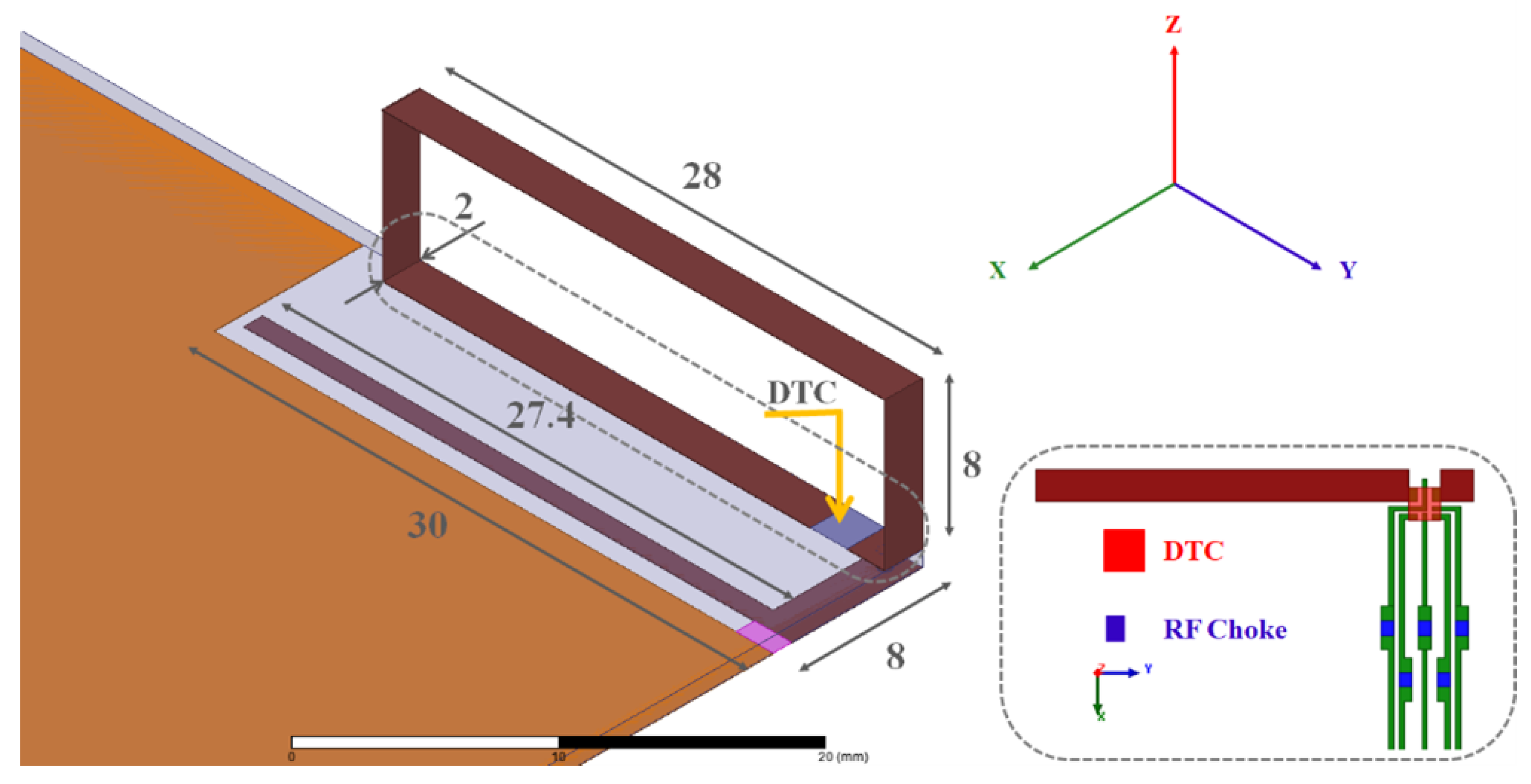
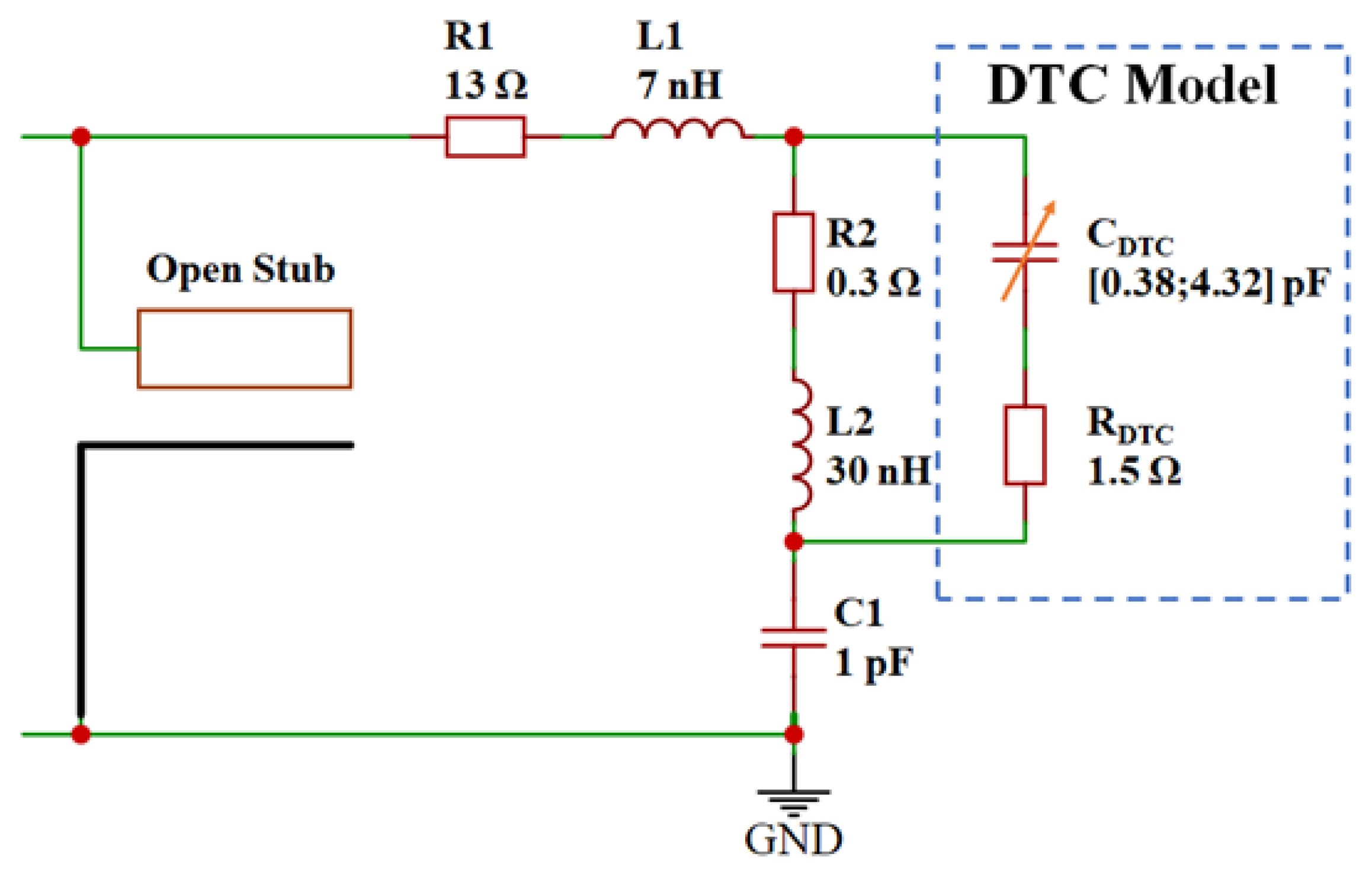
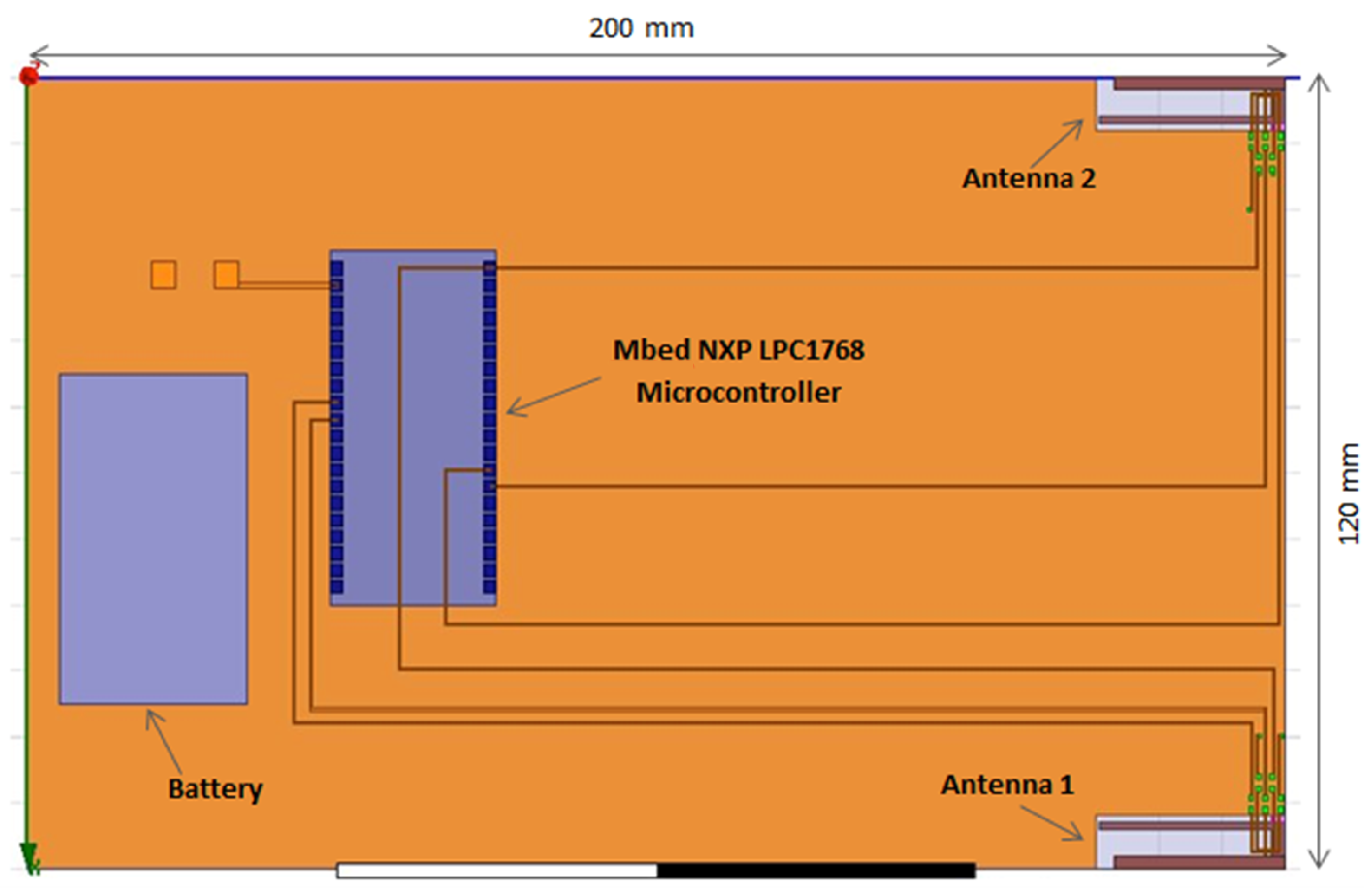
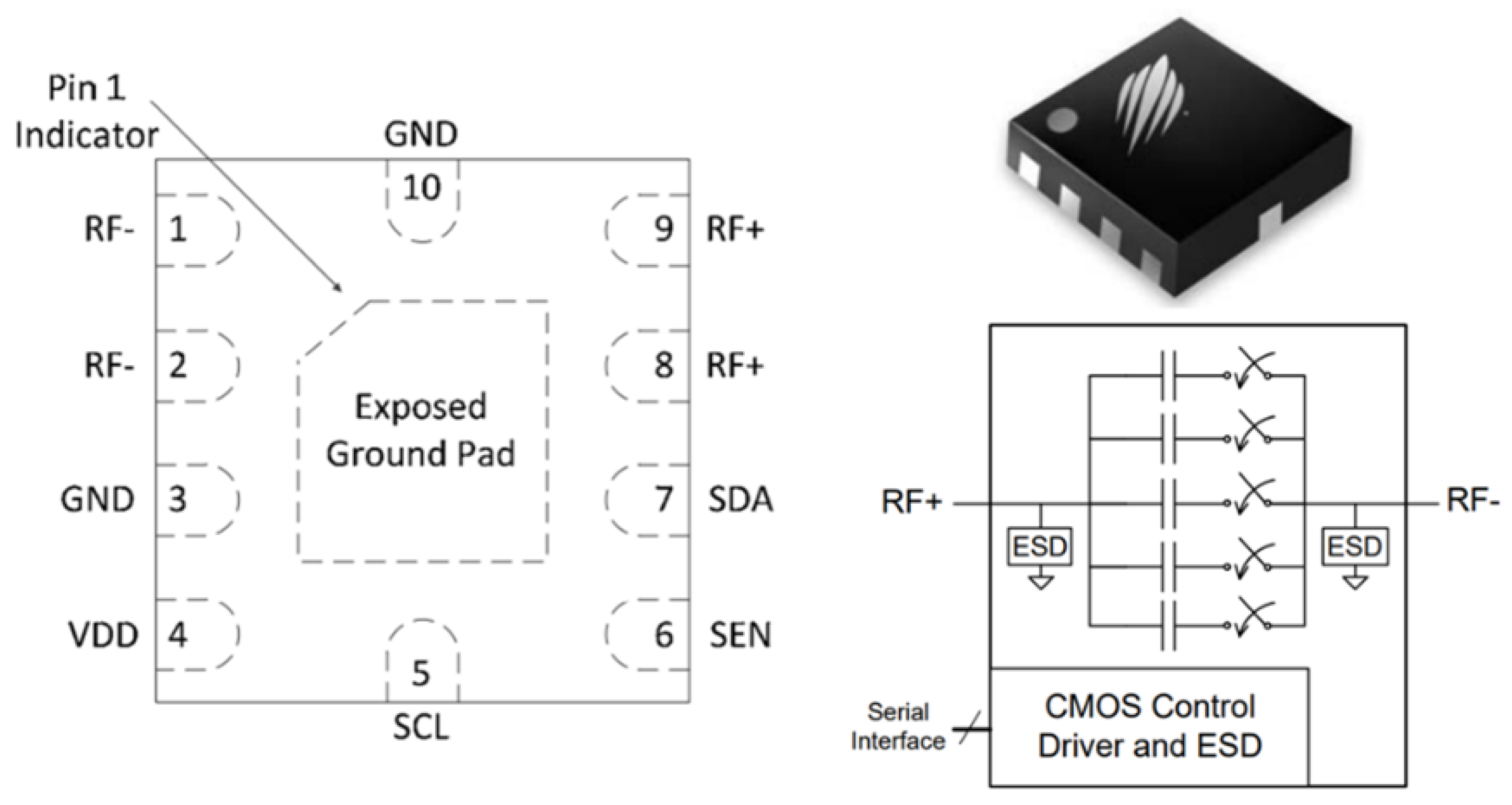

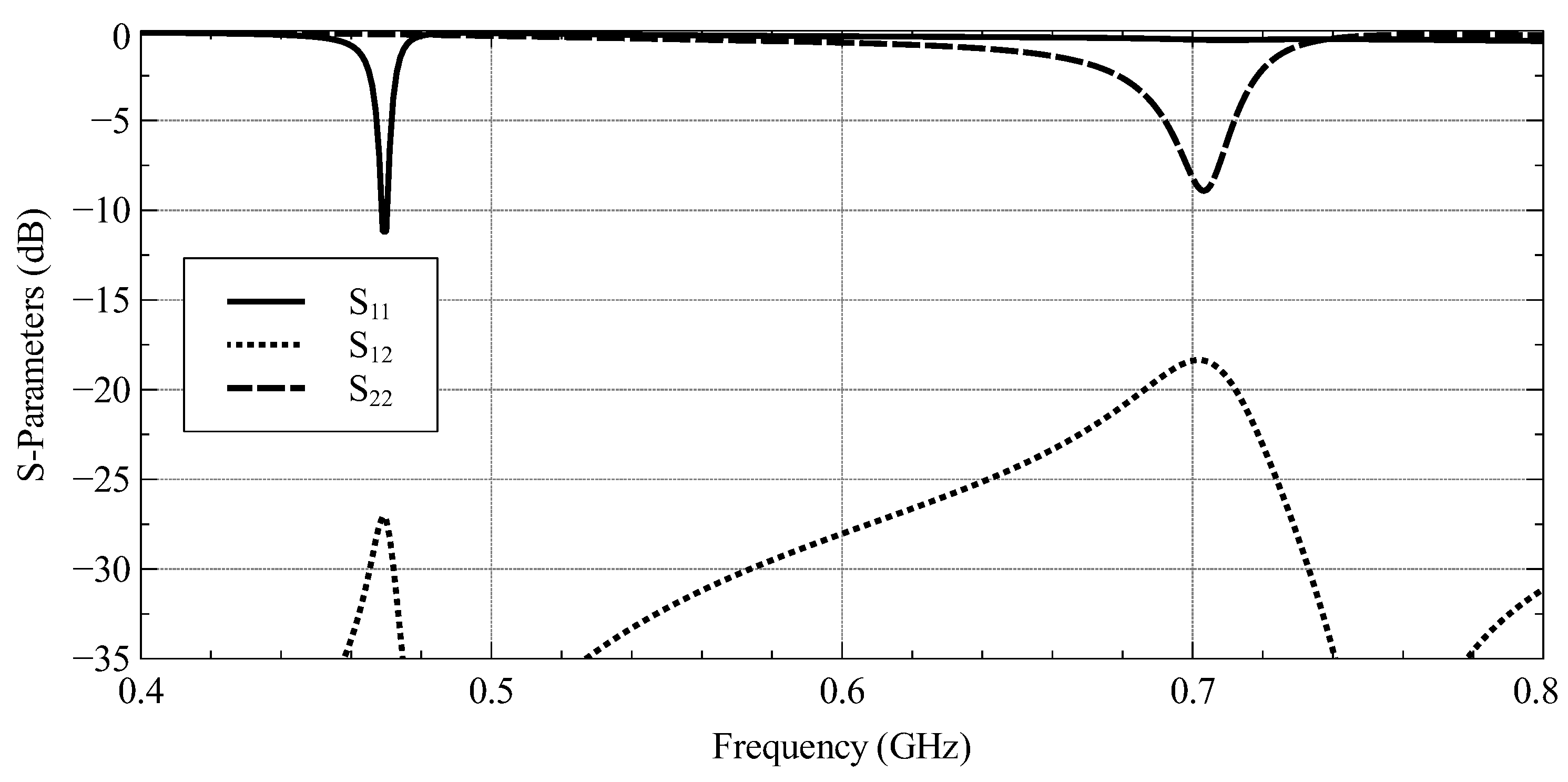

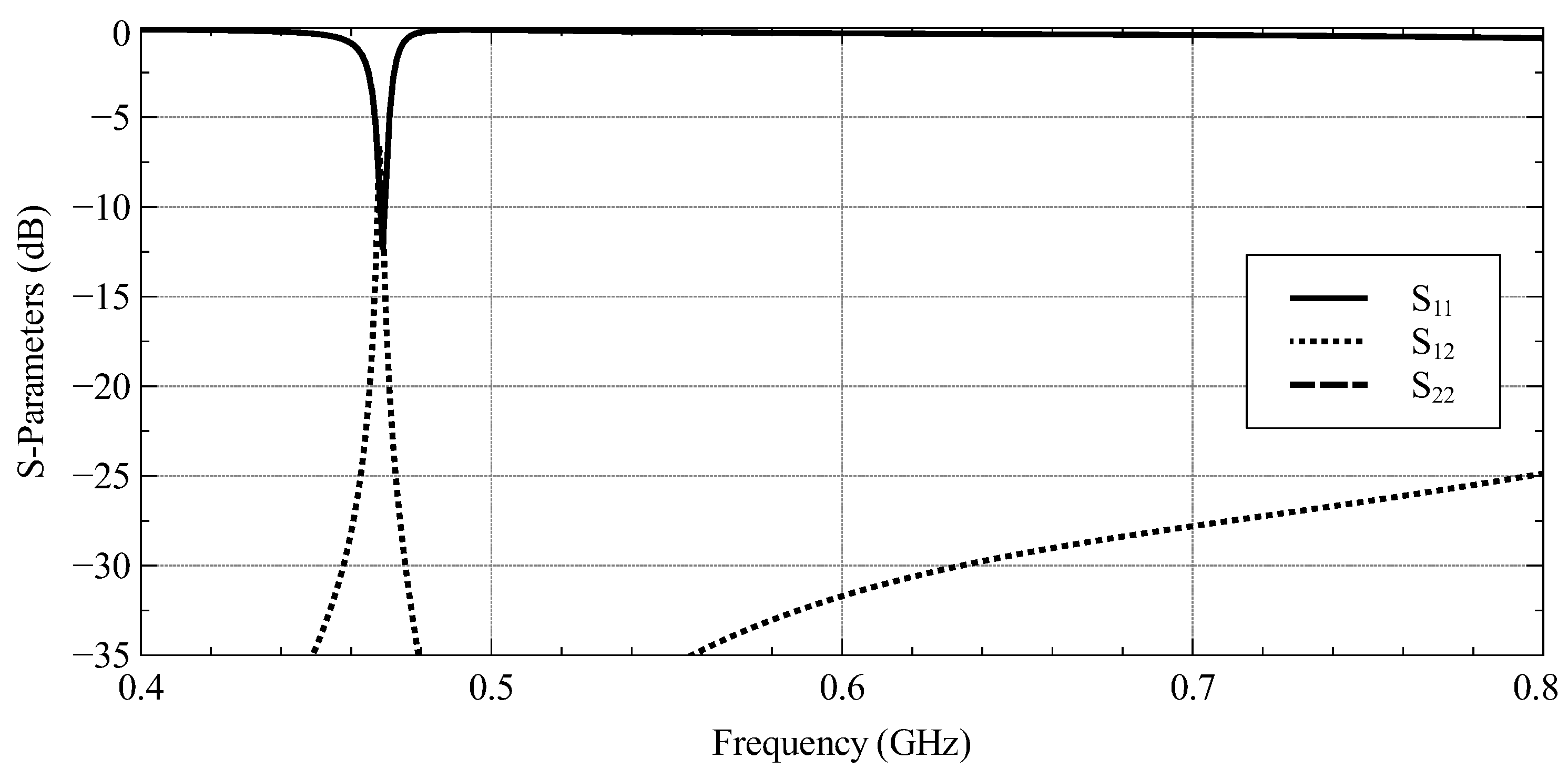
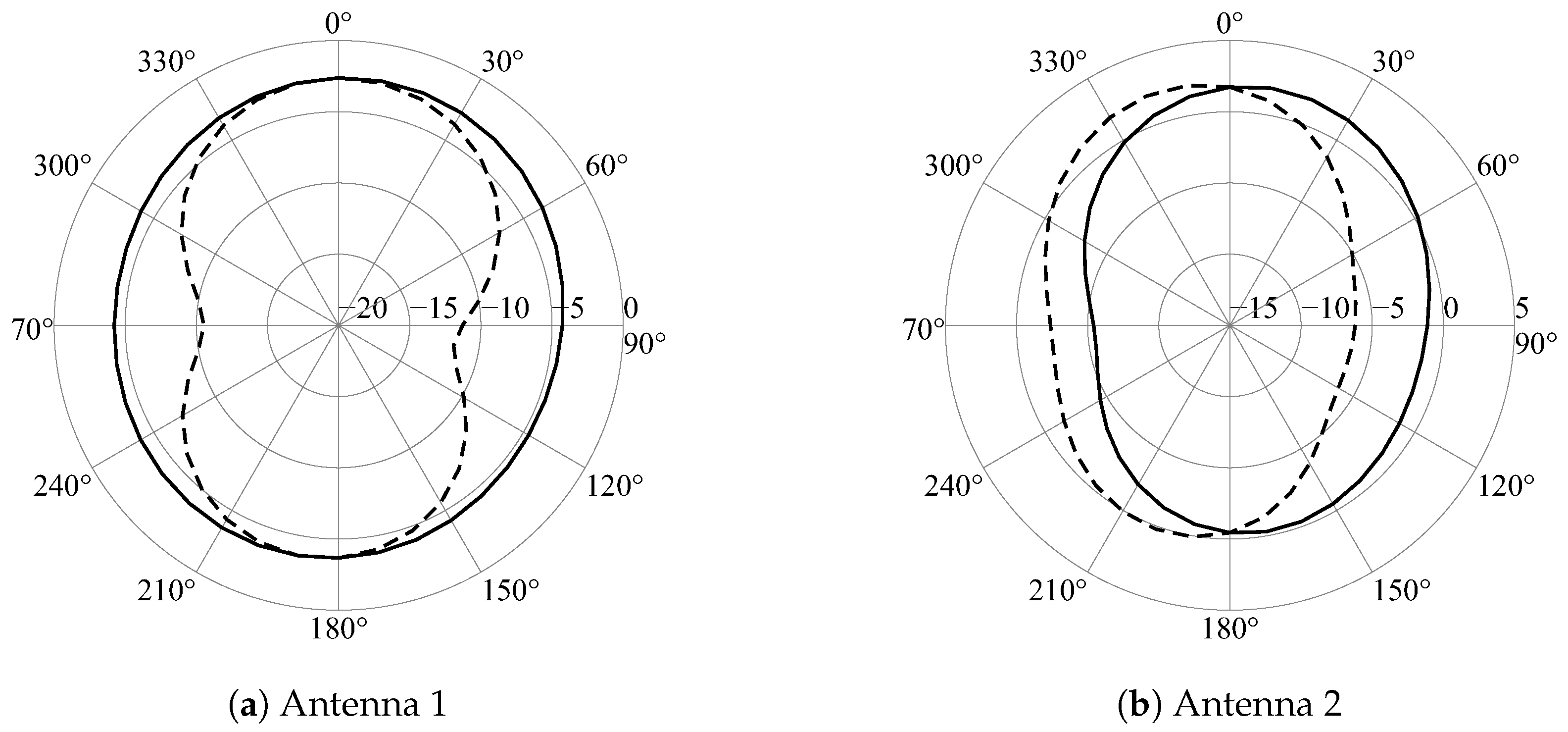
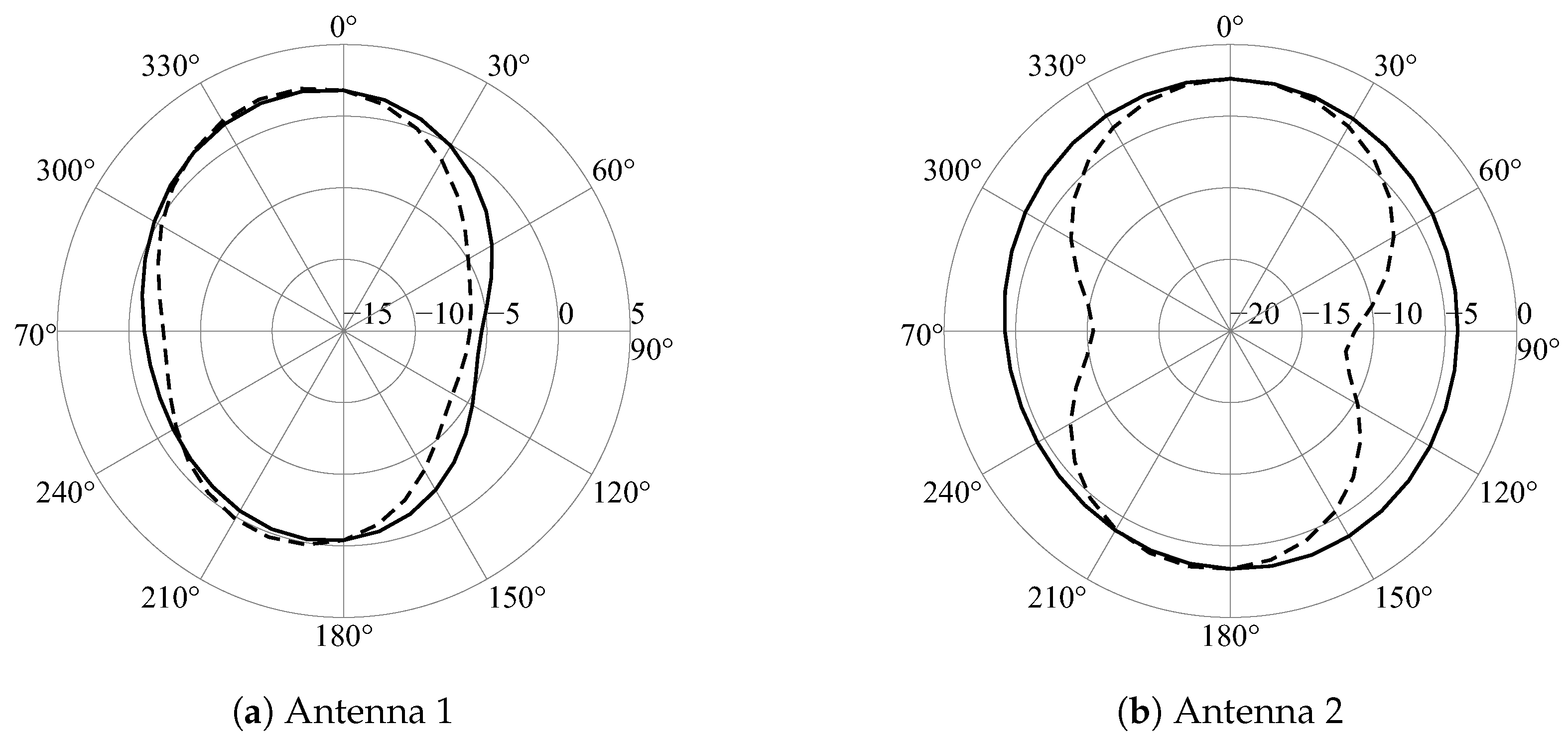
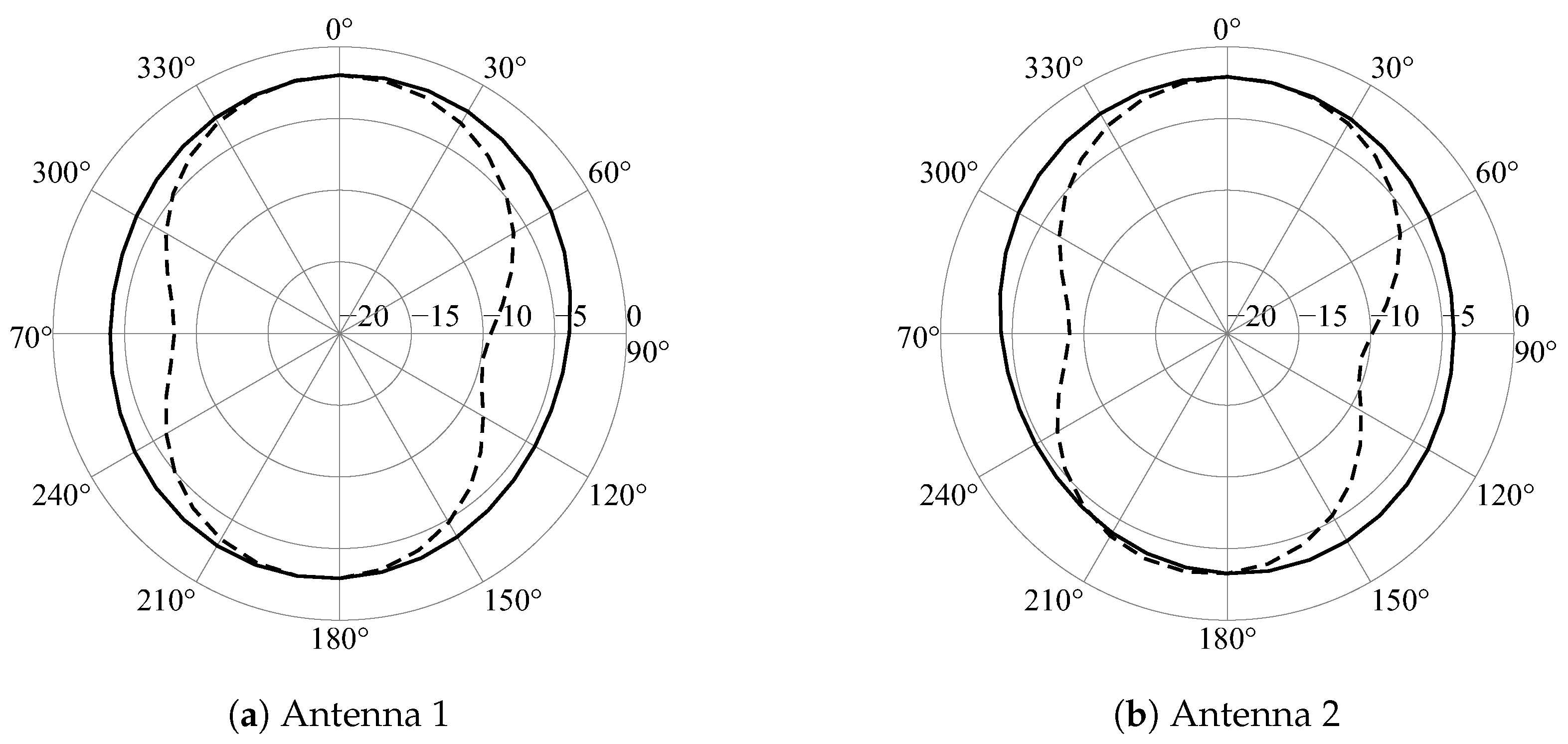

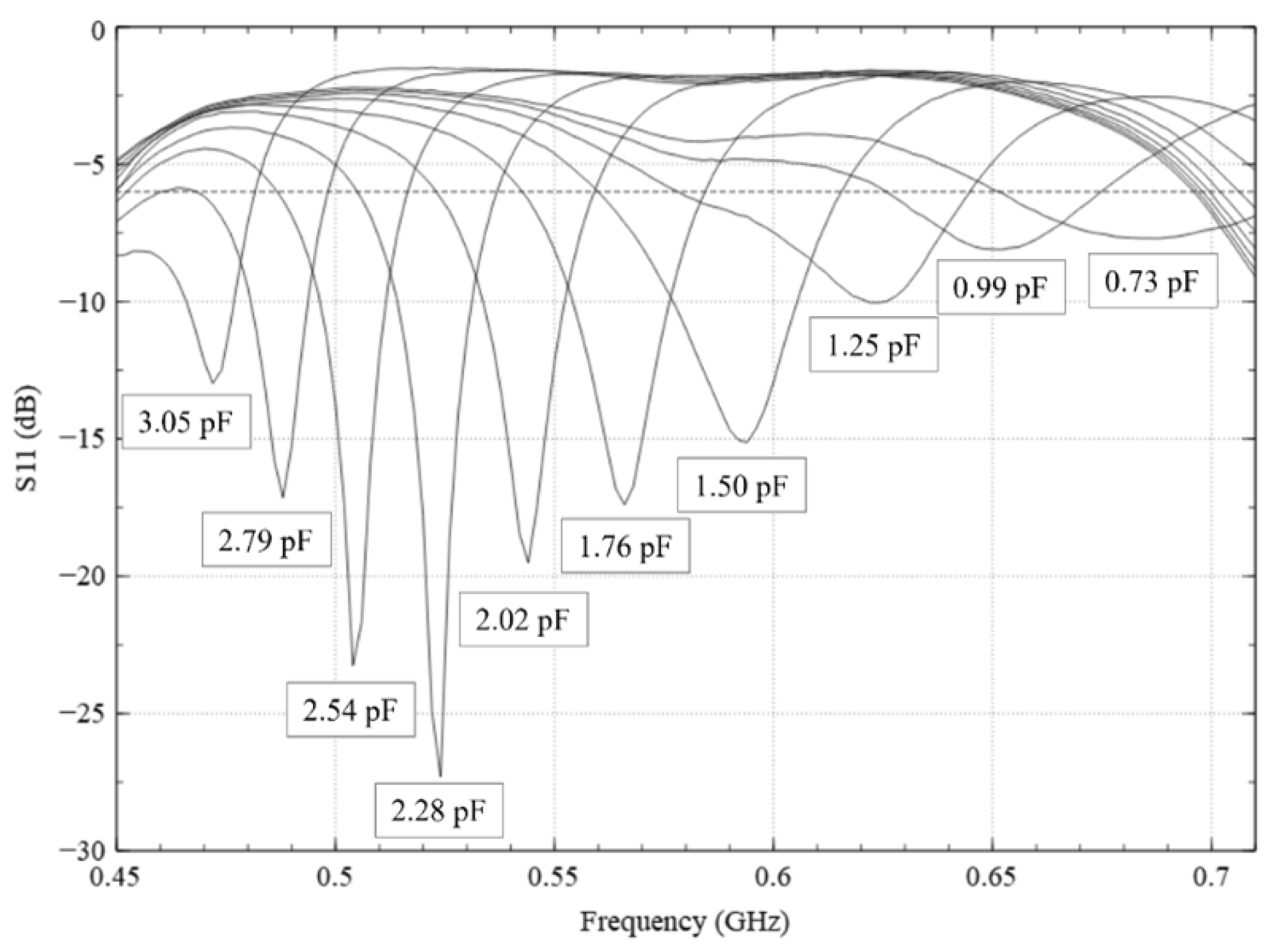
| State | Datasheet (pF) | Measurements (pF) |
|---|---|---|
| 0 | 0.38 | 0.34 |
| 1 | 0.51 | 0.47 |
| 2 | 0.63 | 0.60 |
| 3 | 0.76 | 0.73 |
| 4 | 0.89 | 0.86 |
| 5 | 1.02 | 0.99 |
| 6 | 1.14 | 1.12 |
| 7 | 1.27 | 1.25 |
| 8 | 1.40 | 1.37 |
| 9 | 1.52 | 1.50 |
| 10 | 1.65 | 1.63 |
| 11 | 1.78 | 1.76 |
| 12 | 1.90 | 1.89 |
| 13 | 2.03 | 2.02 |
| 14 | 2.16 | 2.15 |
| 15 | 2.29 | 2.28 |
| 16 | 2.41 | 2.41 |
| 17 | 2.54 | 2.54 |
| 18 | 2.67 | 2.66 |
| 19 | 2.79 | 2.79 |
| 20 | 2.92 | 2.92 |
| 21 | 3.05 | 3.05 |
| 22 | 3.17 | 3.19 |
| 23 | 3.30 | 3.32 |
| 24 | 3.43 | 3.46 |
| 25 | 3.56 | 3.59 |
| 26 | 3.68 | 3.72 |
| 27 | 3.81 | 3.85 |
| 28 | 3.94 | 3.98 |
| 29 | 4.06 | 4.12 |
| 30 | 4.19 | 4.26 |
| 31 | 4.32 | 4.39 |
| Configuration Type | Ant.1 Frequency | Ant.2 Frequency |
|---|---|---|
| Config. 1 | 470 MHz | 700 MHz |
| Config. 2 | 700 MHz | 470 MHz |
| Config. 3 | 470 MHz | 470 MHz |
| Frequency (MHz) | ECC Value |
|---|---|
| 470 | 0.475 |
| 700 | 0.0481 |
| References | Antenna Occupancy Size * | Substrate tan | Frequency Band/Relative Bandwidth |
|---|---|---|---|
| [18] | 0.18 × 0.080 × 0.0020 | 0.0036 | 754–1034 MHz/31.32% |
| [20] | 0.15 × 0.030 × 0.0200 | 0.0250 | 600–950 MHz/45.16% |
| [21] | 0.25 × 0.350 × 0.0003 | 0.0022 | n/a |
| This work | 0.06 × 0.016 × 0.0160 | 0.0250 | 470–700 MHz/39.32% |
Publisher’s Note: MDPI stays neutral with regard to jurisdictional claims in published maps and institutional affiliations. |
© 2022 by the authors. Licensee MDPI, Basel, Switzerland. This article is an open access article distributed under the terms and conditions of the Creative Commons Attribution (CC BY) license (https://creativecommons.org/licenses/by/4.0/).
Share and Cite
Trinh, L.-H.; Ferrero, F. Multiband Frequency Tuneable Antennas for Selection Combining Strategy in White Space Applications. Appl. Sci. 2022, 12, 11062. https://doi.org/10.3390/app122111062
Trinh L-H, Ferrero F. Multiband Frequency Tuneable Antennas for Selection Combining Strategy in White Space Applications. Applied Sciences. 2022; 12(21):11062. https://doi.org/10.3390/app122111062
Chicago/Turabian StyleTrinh, Le-Huy, and Fabien Ferrero. 2022. "Multiband Frequency Tuneable Antennas for Selection Combining Strategy in White Space Applications" Applied Sciences 12, no. 21: 11062. https://doi.org/10.3390/app122111062
APA StyleTrinh, L.-H., & Ferrero, F. (2022). Multiband Frequency Tuneable Antennas for Selection Combining Strategy in White Space Applications. Applied Sciences, 12(21), 11062. https://doi.org/10.3390/app122111062








